Archive for November, 2005
Straight on the heels of our recent fashion show coverage, we’ve decided to showcase local design talent. This week, we caught up with Shivani K, whose women’s clothing collection debuted at San Francisco Fashion Week. The line, which began in 2004, offers an impressive array of dazzling pieces, from a crinkled long-sleeve shirt with diamantes to a silk-lined gold lace top with chiffon ties in the back.

A Shivani K design
(courtesy of SF Fashion Week)
Omiru: How did you get started in fashion design?
Shivani K: At the end of my first year in law school, I decided to take a break because I knew I did not want a career in law. That summer I [went] to be with some relatives in Bombay, India. I needed something to pass the time, so I taught myself to create outfits. Friends of friends started to take notice, and eventually I was making so many pieces and enjoying it so much that I decided to put my efforts and resources into doing [fashion design].
O: What is the inspiration behind your current collection?
SK: Personality and feminine strength, based on the energy emitted by women in my life, from my mother to my best friend to colleagues I admire. There is a commonality among them. Each top was inspired by a different person.
O: What is your design philosophy?
SK: Luxury, glamour, versatility and longevity. [Luxury because] each piece is lined with premium fabrics such as silk charmeuse. Clothes should feel good as well as look good. Glamour because every day is important. Versatility because I believe clothes should blend into your wardrobe yet maintain their unique character. Longevity because the quality is important, and there should be an air of timelessness about piece. I also try to make pieces that can be worn throughout the year without looking silly.
O: What are your thoughts on the San Francisco design scene?
SK: I wish more well-known boutiques that carry bigger brands would also support the local design community to boost visibility…Not a lot of national attention is paid to San Francisco. There isn’t a glitzy or internationally appealing scene in this city. [Because] a lot of designers get overlooked for better-known brands, one feels forced to move somewhere like L.A. or New York.
O: Who are your favorite designers?
SK: I love the original works of Coco Chanel and Christian Dior. Their work was completely unprecedented, but what they did set them apart and steered the entire concept of fashion in a new direction. More recently, I admire the work of Rochas, Lanvin and Armani. I saw a documentary on him [Armani] once, and he said he didn’t put superfluous buttons without a buttonhole on his clothing–that pared-down and practical approach to clothing really impressed me.
O: What trends do you foresee for Spring 2006?
SK: As a caveat, I am the worst person to ask about trends because I firmly believe in the importance of dressing for your body. For spring I would like to see variety as a trend, an increase in casual flattering trousers, a continuation of tasteful lace detailing, delicate prints, pencil skirts, the return of the seamed stocking, lower necklines and sexy details on the back. The back is what it’s all about in ‘06!
For more information on Shivani K, visit www.shivanik.com
November 30th, 2005
Like we said in the women’s edition of Ready Made Outfit: Office Holiday Party, you want to be chic, festive, but not overly dramatic. Our recommendation?
Fashion Formula = Dress Shirt + Interesting Tie + Wool Dress Pants + Black Oxfords.
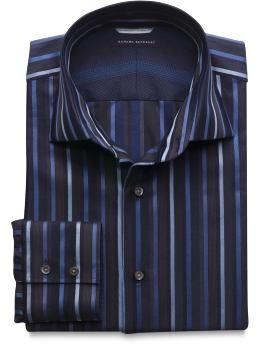
Multi Textured-Stripe Premium Barrel Cuff Shirt | $125 at Banana Republic

BCBG Secize Tie | $29.95 at All Tied Together
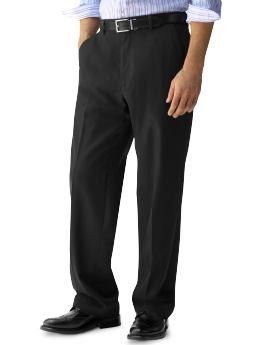
Lightweight Wool Solid Dress Pant | $98 at Banana Republic
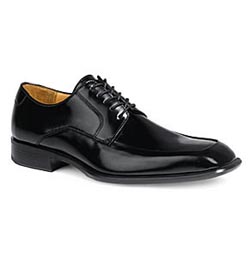
November 29th, 2005
At the office holiday party, you want to be chic, festive, but not overly dramatic. Save the low-cut dresses and overly revealing tops for Friday night out with the girls.
Fashion Formula = Blouse + Tulip Skirt + Cute Pumps.
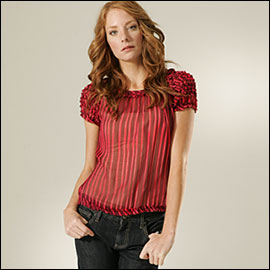
Marc by Marc Jacobs Crinkle Shirt | $228 at
Shopbop
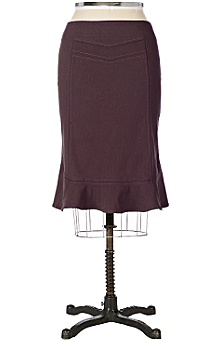
Yin Yang Skirt | $88 at Anthropologie
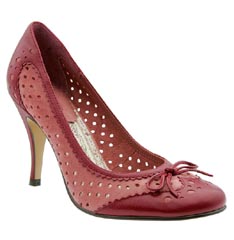
Seychelles "Gentleman Caller" Pump | $64.95 at Nordstrom
November 28th, 2005
We love the frayed detailing that
we’ve been seeing everywhere lately: It’s feminine, yet just a tad
rugged, and elegant without seeming too contrived.
ABS Pink Jeweled Cotton Tank | $105 at Bluefly
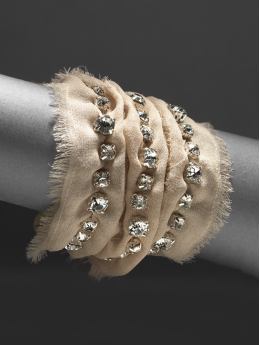
Banana Republic Rhinestone Chiffon Cuff | $19.99 at Banana Republic

Sequin Tank in Heather Pewter | $128 at
J.Crew

Pearl and Silk Ribbon Necklace with Bead Charms | $395 at Kirna Zabete
November 26th, 2005
Considering how impressed we were with Susan Hengst’s collection at the Gen Art Fresh Faces fashion show, imagine our excitement when we discovered that one can now buy Hengst online!
Nymph top in Golden Peach | $210 at Style.com
November 25th, 2005
One of the things
that makes fashion particularly interesting is its position at the
intersection of art and commerce. With one foot in the art world and
the other solidly in the business world, there exists an inherent
tension.
Unsurprisingly,
the fear among the fashion community is that fashion is moving too far
towards the side of commerce. Indeed, the last decade has seen the
close of a number of haute couture houses, perhaps most notably that of
Yves St. Laurent in 2002. But it’s not just couture houses that are in
danger. Teri Agins of the Wall Street Journal wrote in September:
"Mr.
Lam has built a $4.8 million-a-year business but it has yet to reach
the critical mass necessary to operate profitably and efficiently.
Derek Lam Co. will lose money this year, as it has every year since it
was formed in 2002, although Mr. Schlottmann declines to say how much.
Mr.
Lam is part of a new generation of rising fashion stars struggling to
follow the path to financial success blazed by American fashion icons
such as Donna Karan, Calvin Klein, Oscar de la Renta, and Bill Blass.
Handicapped by broad changes in retailing and manufacturing, these
young designers are finding it difficult to capitalize on industry
acclaim and turn a healthy profit."
Agins
is right on the mark when she identifies the financial difficulties
faced by designer ready to wear designers like Derek Lam. Lam’s
contemporaries–Zac Posen, Peter Som, and Behnaz Sarafpour, to name a
few–are also feeling the tension between fashion as art and the need
to make a buck.
Today’s fashion marketplace is especially unfriendly to such designer ready to wear manufacturers. But why is this?
At
the top of the fashion totem pole sits haute couture, where fashion as
art reigns. With a steadily declining number of customers as patrons,
couture is often "subsidized" by other divisions of a luxury
house–fragrances, handbags, perhaps even ready to wear apparel. While
couture isn’t a great revenue generator, it can generate favorable PR,
which intangibly helps other parts of a design house.
On
the other edge of the market sits mass market fashion. Think of
H&M, the Gap, Abercrombie and Fitch. Mall stores and the like that
make their money on volume. However stylish their goods may be, they’re
primarily driven by commerce. At their core, they’re not about a
designer’s artistic vision–they’re about what will increase sales.
Between
these two extremes lies designer ready to wear, the province of the
up-and-coming fashion elite like Lam and Posen. Such designers are
faced to walk the tightrope between art and commerce, and the end
result all too often is failure. In the same WSJ article, Silas Chou,
the former financial backer of Tommy Hilfiger who now backs Michael
Kors, was quoted, "Out of all the 15 or so young designers, there will
probably be just one that will make it and become a big name."
We
don’t pretend to have the answers here, and there are no established
paths for upstart designers to follow, short of giving up (some)
control of the company in exchange for outside money, which is in and
of itself difficult to obtain.
Nevertheless,
we do have hope for the future of fashion art, in spite of luxury
conglomeration, regardless of the travails faced by developing
designers, and in the face of the almighty dollar (or euro, RMB, or
yen). Though intangible artistic merit is difficult to justify on a
balance sheet, its value exists nonetheless…even if it’s only in the
hearts and minds of style philes like us.
November 25th, 2005
While sparkly knits have always been a popular option for the holidays, this year sequined sweaters have really been at the forefront. Besides being glitzy enough for a night on the town, they also happen to be a perfect alternative to the ubiquitous LBT at holiday parties.
Shine Sequin Stripe Sweater in Heather Grey | $132 at Nordstrom
ECI Sparkle Sweater Blazer in Silver | $148 at Nordstrom
Sequin Cardigan in Heather Pewter | $158 at J.Crew
Walter Pointelle Scoop Back Sweater in Gold | $231 at
Nordstrom November 23rd, 2005
In our own biased opinion, we
consider fashion to be the ultimate visual expression of one’s self.
Consciously or unconsciously, your fashion (or anti-fashion) choices
determine how you present yourself to the world…and therefore
contributes to how the world sees you.
We believe that your individuality comes through in three ways:
- What garments you choose,
- How you choose to combine these garments, and
- How you wear that garment combination.
The
first of the three is the most obvious and shouldn’t require much
explanation. If you favor glamour, you might consciously pick a
dramatic top or a slinky skirt. Or if you favor conservatism, on the
other hand, you might choose a high-necked top and/or neutral colors.
How
you choose to combine garments gets a little more interesting. You
might, for example, make a statement by combining a flirty, feminine
skirt with a masculine, military-inspired jacket. Or combining flip
flops with a jet black suit. How you combine garments sheds more
insight into who you are, but at a less conscious level.
But
how you wear that garment combination is perhaps the most telling of
all. You might wear the flip flops + black suit combination with a side
of confidence. Or you might wear it with a sense of indifference. We
believe your attitude is your most important accessory, and it beats a
status handbag, a bewitching pair of pumps, and a sparkly diamond
necklace any day of the week. But to our point, because it is the most
unconscious of your fashion choices, the attitude with which you wear
your outfit offers the most genuine view into who you are.
November 23rd, 2005
On a superficial level (pun intended), dressing chic might appear entirely self-serving. However, I believe fashion has made a greater impact on us as well.
I believe that dressing well indirectly makes me a better person. Clothes make me feel beautiful, while my sense of style allows me to feel unique. When fashionably dressed, I am reassured, more confident, and overall more likely to put forth my best that day. Even when I feel my worst, I can show self-respect by dressing myself well.
While I would like to say that I dress solely for myself, I also know I am judged and categorized by what I wear, and I use this to my advantage. I love that in the same week I can play vixen, bookworm, elegant sophisticate or trendsetter. I love the fact that my quirky selections may keep me from being stereotyped into one category. I love that my outfits reveal other facets of my personality that would otherwise go unnoticed. The exciting transformations that I get to make are what living for fashion is all about.
Susannah
November 22nd, 2005
On the most basic level, fashion is important to me because it makes me happy.
Among
my interests are design and aesthetics, and fashion feeds both of
these. I love line, silhouette, color, fabric, and construction. I love
the look of a well-fitted garment. And I love combining garments to
make a statement.
Fashion
is my way of expressing to the world that I am me. I love that one day,
I can "be" preppy, the next day sophisticated, the next day plain, and
the next day glamourous. It’s the easiest thing to change about your
appearance. Plus it’s non-invasive…a double plus on my list.
I find it intrinsically pleasing to dress up–and I dress for myself, first and foremost.
An added benefit, however, is the visual first impression that you give
to others. It’s been said that first impressions are mainly
visual–that is, they depend less on what you say and more on how you
visually present yourself. While I don’t like this, my experience has
shown this to be all too accurate.
Even when I’m shopping, for
instance, I get radically different treatment from salespeople. If I’m
dressed in flip flops, jeans, and a t-shirt, I often have to hunt
salespeople down in order to make a purchase. If, on the other hand,
I’m dressed in heels, a slim pencil skirt, and a nice top, I often
can’t shop in peace, receiving multiple offers for help.
Your thoughts? How does fashion make an impression on your life?
Trisha
November 21st, 2005
Previous Posts
















